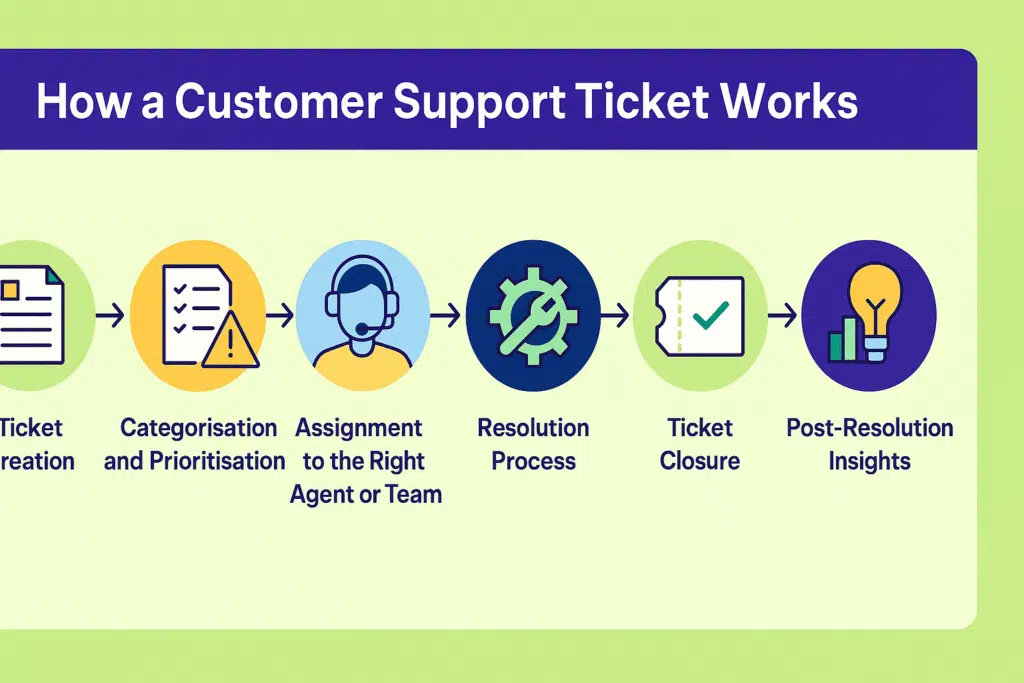What is a Customer Support Ticket?
- September 15th, 2025 / 5 Mins read
-
Aarti Nair

What is a Customer Support Ticket?
- September 15th, 2025 / 5 Mins read
-
Aarti Nair
Guide on Customer Support Tickets
Every customer query is a story—sometimes it’s a simple “Where’s my order?” and other times it’s a complex issue that needs multiple teams to jump in. For support teams to manage this at scale, they need structure. That’s where customer support tickets come in.
A support ticket acts as a digital record of a customer’s request or problem. It captures all the essential details—who raised it, what the issue is, when it was raised, and how it was resolved. This makes tickets the backbone of organised, trackable, and transparent customer service.
But tickets aren’t just about logging problems. They’re also an opportunity to improve efficiency. In fact, research shows that 22% of total service desk tickets can be resolved at practically no cost with automation. That means faster responses for customers, less workload for agents, and significant savings for businesses.
Understanding what a support ticket is—and how to use it effectively—can be the difference between chaotic support and customer experiences that inspire trust.
What is a Customer Support Ticket?
A customer support ticket is a digital record of a customer’s request, question, or issue with a product or service. Think of it as a “case file” that logs everything about the problem—from the moment the customer raises it to the point where it’s resolved.
When a customer sends an email, fills out a form, uses live chat, or calls the support line, the system creates a ticket. This ticket acts as a single source of truth where all the details are captured:
Who the customer is
What the issue is about
When it was reported
Which agent is handling it
What actions have been taken so far
Unlike informal conversations, tickets are structured and trackable. They ensure no request slips through the cracks, agents have full context, and customers get consistent updates.
Customer support tickets also make service scalable. For example, with automation, repetitive issues like password resets or order tracking can be resolved without human involvement—freeing up agents for more complex problems.
Anatomy of a Customer Support Ticket
A customer support ticket isn’t just a placeholder for a problem—it’s a structured record designed to capture every relevant detail of the customer’s journey. Think of it as a “case file” that helps agents understand, prioritise, and resolve issues without losing context. Let’s break down the key elements in detail:
1. Ticket ID
Every ticket is assigned a unique identification number when it’s created. This ID acts as the reference point for both the customer and the support team. Instead of saying “I raised an issue yesterday,” the customer can say “My ticket number is #10342.”
For agents, this ensures accountability and easy searchability in the support system.
For customers, it builds confidence that their request is being tracked and won’t get lost in the shuffle.
2. Customer Information
This section contains all the details that identify the customer—name, email, phone number, account ID, subscription plan, or purchase history.
Having this data upfront saves time since agents don’t have to repeatedly ask for basic information.
It also provides context, such as whether the customer is a first-time user, a long-time client, or a high-value account—helping teams prioritise and personalise their responses.
3. Issue Description
The issue description is essentially the problem statement written either by the customer (via chat/email form) or by an agent (during a phone call).
The clearer and more detailed this section is, the faster the resolution.
For example: “App keeps crashing when I try to upload a PDF on iOS version 17.1.” is far more useful than “App not working.”
Good ticketing systems encourage structured issue descriptions by prompting users to select categories or provide screenshots.
4. Category and Priority
Not all tickets are created equal. Categorisation and prioritisation help the support system route queries efficiently:
Categories: Technical issue, billing query, account access, product feedback, etc.
Priority levels: Low (general question), Medium (feature not working), High (payment failure), Critical (security breach).
This ensures that an urgent ticket—say, a customer unable to access funds in their bank account—doesn’t wait behind a low-priority request like a marketing opt-out.
5. Status
The ticket status tells both the customer and the support team where things currently stand. Common statuses include:
Open (ticket created but not yet worked on)
In Progress (assigned to an agent and being handled)
Escalated (sent to a higher-tier support team or specialist)
Resolved/Closed (issue has been addressed and customer confirmed or feedback collected).
This visibility reduces uncertainty and builds trust, since customers can see that their request is moving forward.
6. Conversation History
One of the most important parts of a ticket is the running log of interactions between the customer and support team.
This may include emails, chat transcripts, call notes, and even attachments like screenshots or invoices.
A complete conversation history ensures continuity. Customers don’t have to repeat themselves every time a new agent gets involved, and agents can quickly understand the context before responding.
7. Assigned Agent or Team
The ticket clearly shows who is responsible for resolving it. This can be an individual agent, a specialist team, or even an automated AI agent for simpler requests.
Assignment brings accountability—customers know who’s working on their case.
It also helps in internal reporting and performance reviews, since managers can see resolution trends per agent/team.
8. Resolution Notes
Once an issue is resolved, the agent records what was done to fix it in the ticket.
These notes are valuable not only for future reference if the same customer faces the problem again, but also for training purposes and knowledge base updates.
For example: “Reset customer’s account password and verified login. Issue resolved.”
Over time, resolution notes help identify patterns—like recurring bugs or frequent billing errors—that may need a systemic fix.
How a Customer Support Ticket Works?
A customer support ticket acts like a guided journey—from the moment a problem is raised to the moment it’s resolved. It ensures that customer issues are handled systematically, with complete visibility for both the support team and the customer. Here’s how the process typically works:
1. Ticket Creation
Whenever a customer reaches out—via email, live chat, social media, or phone call—the support system generates a new ticket. This ticket captures the query along with key customer details (like name, account ID, or contact info) and assigns a unique ticket ID for easy tracking.
2. Categorisation and Prioritisation
Once created, the ticket is categorised by type (billing, technical, account access, etc.) and given a priority level (low, medium, high, critical). This ensures urgent issues, like failed payments, are addressed faster than general questions. Many systems use automation here to tag and prioritise tickets instantly.
3. Assignment to the Right Agent or Team
The ticket is then routed to the most suitable agent or department. For example, a login error goes to the IT team, while a refund query is assigned to billing. Modern systems (with AI) can auto-assign tickets, saving hours of manual sorting.
4. Resolution Process
The assigned agent investigates the issue, communicates with the customer if additional information is needed, and works on resolving the problem. Every step—updates, notes, or escalations—is recorded inside the ticket so the entire history stays in one place.
5. Escalation (If Needed)
If the issue can’t be resolved at the first level, the ticket can be escalated to senior agents or specialists. Thanks to the conversation history, escalated agents don’t need to ask customers to “start over.”
6. Ticket Closure
Once the issue is resolved, the ticket is marked as closed. Customers are usually notified and may be asked for feedback (like a CSAT rating or short survey). This not only confirms satisfaction but also feeds insights back into the support process.
7. Post-Resolution Insights
Closed tickets don’t just disappear—they become part of the organisation’s knowledge base. By analysing ticket data, businesses can spot recurring problems, identify training gaps, and automate fixes for repetitive issues in the future.
Types of Customer Support Tickets
Not every support ticket is the same. Depending on the nature of the issue and the channel it comes from, tickets can take different forms. Understanding these types helps teams categorise, prioritise, and resolve them more effectively.
1. Technical Support Tickets
These involve product or service malfunctions—software bugs, login errors, system crashes, or hardware glitches.
Example: “The app crashes whenever I try to upload a file.”
Usually routed to the IT or product engineering team for resolution.
2. Billing and Payment Tickets
These cover issues related to invoices, refunds, subscription renewals, or failed transactions.
Example: “I was charged twice for my monthly plan.”
Typically assigned to the finance or billing team.
3. Account and Access Tickets
These involve login problems, password resets, permission errors, or account verification.
Example: “I can’t reset my password and I’m locked out of my account.”
Often resolved quickly with automation, such as password reset links.
4. General Queries and Information Requests
Customers sometimes raise tickets just to ask questions, clarify policies, or request product information.
Example: “Do you offer a student discount plan?”
These can often be handled instantly with knowledge base articles or chatbots.
5. Feature Requests and Feedback Tickets
Not every ticket is about a problem—customers also use them to suggest new features or share feedback.
Example: “It would be great if the app supported dark mode.”
Valuable for product teams to gather customer insights.
6. Complaint or Escalation Tickets
These involve dissatisfied customers who may have had a poor experience. Complaints need careful handling with empathy and often require escalation to senior support staff.
Example: “I’ve reported this issue twice and it’s still unresolved.”
7. Automated or System-Generated Tickets
Some tickets are created automatically by monitoring tools or bots—like system downtime alerts or suspicious account activity.
Example: “Unusual login attempt detected from a new location.”
These proactive tickets help prevent issues before customers even notice them.
By categorising tickets into these types, businesses can streamline workflows, assign them to the right teams, and even automate resolutions for repetitive issues—freeing up human agents for complex, high-value cases.
| Type of Ticket | Example | Who Handles It |
|---|---|---|
| Technical Support | “The app crashes whenever I try to upload a file.” | IT support / Engineering team |
| Billing & Payment | “I was charged twice for my monthly plan.” | Finance / Billing team |
| Account & Access | “I can’t reset my password and I’m locked out.” | Customer support / Automation |
| General Queries | “Do you offer a student discount plan?” | Frontline agents / Knowledge base |
| Feature Requests & Feedback | “It would be great if the app supported dark mode.” | Product / Customer success |
| Complaints & Escalations | “I’ve reported this issue twice and it’s still unresolved.” | Senior agents / Escalation desk |
| Automated/System-Generated | “Unusual login attempt detected from a new location.” | Automated monitoring / Security team |
The Ticket Management Process
Managing support tickets isn’t just about logging issues — it’s about moving customers from frustration to resolution as quickly and smoothly as possible. But how exactly does that happen? Let’s walk through the process step by step.
1. Ticket Creation
Think about the last time you reached out to a company for help — did you email, call, or use chat? That’s where ticket creation begins. Whenever a customer submits a query through email, phone, chat, or a support portal, the system generates a ticket with their details, the issue description, and any attachments (like screenshots or error logs).
Submission Channels: Why does this matter? Because customers expect choice. Some prefer the formality of email, others want the immediacy of chat. Portals often add automation — like instant confirmation messages — which reassure customers their problem won’t disappear into a void.
Collecting Essential Information: Here’s a tip — the quality of a ticket depends on the quality of the information. A vague “App not working” makes an agent’s job harder than “App crashes when uploading a PDF on iOS 17.1.” Screenshots, error codes, and detailed descriptions speed up diagnosis.
Initial Acknowledgment: Ever felt ignored after submitting a request? That’s why acknowledgment matters. An auto-response with a ticket ID or estimated response time sets the right expectations from the start.
2. Ticket Categorisation and Prioritisation
Now the question is: Which issues should be handled first? This is where categorisation and prioritisation step in.
Importance of Categorisation: A billing issue needs a different team than a technical bug. Smart systems can tag and route tickets automatically, ensuring the right people see the right problem.
Strategies for Prioritisation: Not every ticket has the same urgency. A password reset can wait a bit, but a payment failure or system outage? That’s high priority. Having a framework ensures resources are allocated wisely.
Balancing Workloads: Ever seen some agents drowning in tickets while others sit idle? A balanced system prevents bottlenecks by distributing work based on urgency and complexity.
3. Ticket Assignment
Once sorted, tickets need to land in the right hands. But should this be manual or automated?
Manual vs. Automated Assignment: Smaller teams may prefer manual assignment for personalisation. Larger organisations lean on automation to distribute tickets instantly and fairly. The key is making sure no ticket goes unnoticed.
Matching Expertise: A technical outage should go to a tech-savvy agent, not someone handling billing. Matching skill to issue shortens resolution time and boosts customer confidence.
Monitoring Assignments: Assignments aren’t “set and forget.” Managers should monitor distribution and adjust when certain agents are overloaded.
4. Ticket Resolution
This is where the real magic happens: solving the customer’s problem. But how?
Diagnosing the Problem: Agents need to play detective. Asking probing questions, replicating the error, or digging into logs helps uncover the root cause rather than just patching symptoms.
Providing and Communicating Solutions: Customers want clarity. Instead of vague updates, explain the fix with steps and expected outcomes. The more transparent the communication, the more trust you build.
Escalation Procedures: What happens when the agent hits a wall? Escalation ensures the ticket moves to specialists or higher-level support without customers repeating themselves.
5. Ticket Closure
The last step isn’t just ticking a box. It’s about closing the loop properly.
Communicating Resolution: Let the customer know what was fixed and confirm they’re satisfied. A ticket isn’t truly resolved unless the customer feels heard.
Gathering Feedback: Why not turn closure into a learning opportunity? A quick survey (CSAT or NPS) can reveal how customers perceive your support quality.
Continuous Improvement: Closed tickets are data goldmines. Analysing patterns helps teams refine processes, train agents better, and even improve products.
Challenges in Ticket Management
If ticket management were simple, every customer would get lightning-fast, perfect support. But reality tells a different story. Teams often hit roadblocks that slow down responses and frustrate customers. So, what are the most common challenges?
1. High Ticket Volume
Have you ever logged in on a Monday morning to find hundreds of new tickets waiting? High volumes can overwhelm teams, especially during product launches, outages, or seasonal peaks. Without proper automation and prioritisation, urgent issues get buried under routine ones.
2. Poor Ticket Categorisation
What happens when a billing query gets routed to the technical team? Delays. Mis-categorisation leads to wasted time, frustrated agents, and annoyed customers. Smart tagging and automated routing are critical, but many teams still rely on manual categorisation — and that’s error-prone.
3. Long Resolution Times
Customers don’t just want answers — they want them fast. Tickets that bounce between agents or require repetitive back-and-forth drag resolution times out. This not only hurts satisfaction but also increases support costs.
4. Lack of Context and History
How many times have you heard customers say: “I’ve explained this before…”? When agents don’t have access to full conversation history, customers are forced to repeat themselves, creating frustration on both sides.
5. Inefficient Escalation
Escalation should feel seamless, but in many organisations, it’s messy. Tickets get stuck at one level too long or escalated without enough context, which slows down resolution instead of speeding it up.
6. Agent Burnout
What happens when teams deal with repetitive, high-pressure tickets daily without the right tools? Burnout. Overloaded agents struggle to stay motivated, leading to mistakes, longer response times, and higher turnover.
7. Limited Use of Automation
Remember that stat — 22% of tickets can be resolved at practically no cost with automation?
Yet, many organisations underuse automation tools. Without chatbots, AI agents, or workflow automation, simple tickets like password resets eat up valuable agent time.
Recognising these challenges is the first step. The next is building smarter systems — with better categorisation, automation, and analytics — so tickets become opportunities for customer delight, not bottlenecks.
Best Practices for Overcoming Ticket Management Challenges
If the challenges of ticket management feel overwhelming, the good news is this: most of them can be solved with the right mix of process, technology, and mindset. So how do you turn ticket chaos into customer satisfaction?
1. Automate Repetitive Tasks
Why should an agent spend 10 minutes resetting a password when a chatbot can do it instantly? By automating repetitive queries — order tracking, password resets, basic FAQs — teams free up agents to focus on complex issues. This not only reduces workload but also improves response times.
2. Use Smart Categorisation and Routing
Imagine a world where every billing query goes directly to finance and every technical glitch lands with IT — no manual sorting, no delays. AI-driven categorisation and routing tools make this possible, ensuring tickets reach the right agent or team from the start.
3. Prioritise Based on Impact
Not all tickets are created equal. A service outage affecting thousands of users needs immediate attention, while a feature request can wait. Build a prioritisation framework that balances urgency and impact, so high-priority tickets always move to the top of the queue.
4. Give Agents Full Context
How can an agent deliver quick resolutions if they don’t know the customer’s history? Integrating your ticketing system with CRM ensures every agent has full visibility into past interactions, purchases, and preferences. No more making customers repeat themselves.
5. Establish Clear Escalation Paths
When escalation is inevitable, make it smooth. Define clear rules for when and how tickets should move up the ladder. Include context, conversation history, and any troubleshooting already done — so higher-level teams can act immediately instead of starting over.
6. Monitor Metrics and Feedback
Are your tickets taking too long to resolve? Are customers satisfied with the answers they get? Tracking metrics like First Response Time (FRT), Resolution Rate, and CSAT, combined with regular feedback, helps teams spot gaps and continuously improve.
7. Support Your Agents
Happy agents create happy customers. Provide training, knowledge-sharing sessions, and tools like AI-assist to make their jobs easier. Reducing manual effort lowers burnout and boosts efficiency across the board.
Ticket management doesn’t have to be overwhelming. With the right strategy, automation, and human support, it becomes less about handling problems and more about creating opportunities to delight customers.
Tools for Efficient Ticket Management
Managing tickets efficiently isn’t just about having a process — it’s about equipping your team with the right tools. The right ticketing software can mean the difference between drowning in unresolved issues and delivering seamless customer experiences. But what should you look for in these tools?
1. Centralised Ticketing System
How do you keep track when tickets come in from email, chat, phone, and social media? A centralised ticketing platform pulls all requests into one dashboard. This prevents issues from slipping through the cracks and makes it easy for agents to respond faster.
2. Automation and AI Agents
Why let humans handle repetitive queries when AI can resolve them instantly? Modern tools integrate chat and voice AI agents to automatically handle FAQs, password resets, and order updates. This not only saves time but also ensures customers get responses 24/7.
3. Smart Categorisation and Routing
Misrouted tickets waste time. AI-powered systems categorise issues by type and route them to the right agent or department automatically. For example, a billing query goes straight to finance, while a technical bug is sent to IT.
4. Knowledge Base Integration
How often do customers ask the same questions? Integrating a self-service knowledge base with your ticketing tool lets customers resolve simple issues themselves — reducing ticket volume while empowering users.
5. Collaboration Features
Not every ticket can be solved by one person. The best systems include internal notes, tagging, and team collaboration tools. This ensures smooth handovers and keeps everyone on the same page.
6. Analytics and Reporting
Do you know how long it takes your team to resolve a ticket? Or which issues crop up most often? Built-in analytics help track metrics like First Response Time (FRT), Resolution Rate, and CSAT. These insights drive smarter decisions and continuous improvement.
7. Multi-Channel Support
Customers don’t stick to one channel — they hop between chat, email, WhatsApp, and calls. A tool that supports multiple channels ensures every ticket is tracked, no matter where the conversation started.
Investing in the right tools is like upgrading from a crowded inbox to a mission-control dashboard. It streamlines workflows, empowers agents, and keeps customers happy.
Turning Support Tickets Into Customer Delight with Verloop.io
Support tickets aren’t just logs of issues — they’re opportunities to deliver faster resolutions, build trust, and improve customer satisfaction. But the real question is: how can businesses make ticket management more efficient and impactful?
This is where Verloop.io comes in. With AI Chat and Voice AI Agents, banks and enterprises can automate routine ticket resolutions — from password resets to account queries — cutting response times from minutes to seconds. For complex issues, Verloop.io’s dashboard gives managers and agents a single view of every customer conversation, ensuring seamless context even across channels.
And here’s the best part: you don’t have to replace your existing system. Verloop.io integrates with Zendesk and other ticket management platforms, so you can enhance, not disrupt, your current workflows.
By combining automation, omnichannel support, and deep insights, Verloop.io transforms tickets from a burden into a driver of customer delight.
👉 Ready to simplify ticket management and deliver next-level CX?









